Message from the Chair

Greetings OSAC members! What an interesting time we have lived through since my last Message from the Chair. We are living in unprecedented times and the events of recent months have many in a state of unrest and uncertainty. Through it all, the members of OSAC have continued to work diligently to move the forensic sciences in a positive and professional direction. As we continue through the summer, I hope and pray that you and your families are faring well, staying healthy and remaining safe.
As we approach the end of FY 2020, we are nearing the completion of our sixth full year of existence. As a charter member of the Forensic Science Standards Board (FSSB), I’ve been part of the OSAC mission since its inception. I can’t believe how quickly the time has flown by! Throughout it all, I’ve never ceased to be amazed at the intelligence, dedication and cooperation of the OSAC community. Another element impacting me personally is my second term as the International Association for Identification (IAI) representative to the FSSB will be ending this September. Per OSAC Charter and Bylaws, I will have to step away from this responsibility, as well as my role as FSSB chair. When I was asked in September 2017 if I would be willing to serve as chair, I had my doubts as to whether I was qualified. I found out soon enough that the exceptional leaders on the FSSB were incredibly supportive of me. I can’t thank them enough for “putting up” with me, and I especially want to thank the OSAC Program Office (OPO) for their assistance over the years.
During these past six years I’ve renewed or initiated personal and professional relationships with many of you and look forward to continuing our communications and standards development efforts beyond my participation in OSAC. With the implementation of OSAC 2.0 expected to be in full swing by October of this year, we have a lot of work ahead of us and the mission of OSAC becomes even more important as the word gets out about our great organization.
The pandemic has put a significant damper on our ability to physically get together to meet, either as the FSSB or in plenary sessions. Who would have thought that our first plenary session in Norman, Oklahoma last March would be our last for the foreseeable future? When and where we will meet in-person again remains undetermined, but I trust that the OPO, in conjunction with NIST, will endeavor to make those meetings happen when the circumstances allow. I’m also fully confident that the OPO will do the same superb job in executing and managing those meetings as they have done in the past.
Finally, I want to thank all of you for your continued hard work – it has not gone unnoticed! OSAC is recognized across the country and around the world as an exemplary organization. You can all take significant pride for your participation in our mission. I know that I am but one of many that will have to step away from their roles on OSAC, as roughly one-third of the membership will be ending their second term of service. That said, I trust those who remain and those who will be stepping into new positions will continue the fine work we’ve come to expect from OSAC. Continue to go forth and do great things!
Respectfully submitted,
Steven Johnson, Chair, OSAC Forensic Science Standards Board
OSAC 2.0 Updates
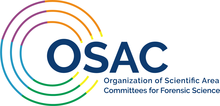
The FSSB, in collaboration with the NIST’s OSAC Program Office, has implemented the following changes in preparation for OSAC 2.0, set to launch on October 1, 2020.
The Scientific Area Committee (SAC) and subcommittee structure and names have been finalized. At their quarterly meeting this May, the FSSB reviewed the structure and names of the SACs and subcommittees. The following seven SACs and 22 subcommittees under OSAC 2.0 will include:
- Biology SAC
- Human Forensic Biology
- Wildlife Forensic Biology
- Chemistry: Seized Drugs & Toxicology SAC
- Forensic Toxicology
- Seized Drugs
- Chemistry: Trace Evidence SAC
- Ignitable Liquids, Explosives, & Gunshot Residue
- Trace Materials
- Scene Examination SAC
- Crime Scene Investigation & Reconstruction
- Dogs & Sensors
- Fire & Explosion Investigation
- Medicine SAC
- Forensic Anthropology
- Forensic Nursing
- Forensic Odontology
- Medicolegal Death Investigation & Disaster Victim Identification
- Digital/Multimedia SAC (no SC changes)
- Digital Evidence
- Facial Identification
- Speaker Recognition
- Video Imaging/Technology & Analysis
- Physics/Pattern Interpretation SAC (no SC changes)
- Bloodstain Pattern Analysis
- Firearms & Toolmarks
- Footwear & Tire
- Forensic Document Examination
- Friction Ridge
The Scientific and Technical Review Panel (STRP) process has been drafted and submitted to the FSSB for review. The new STRP Terms of Reference (ToR) and Instructions for Reviewers were presented to the FSSB at their May meeting and are currently under review for use in a pilot process beginning this summer.
OSAC governing and process documents have been updated. All OSAC processes, procedures, and ToRs were reviewed and are being updated to align with OSAC 2.0 changes. Additionally, a new ToR was developed for Interdisciplinary Committees and Task Groups. Once approved, these documents will be available on the OSAC website.
Contact the OSAC Program Office at forensics [at] nist.gov (forensics[at]nist[dot]gov) with any questions about OSAC 2.0 implementation.
OSAC Registry and Implementation Corner
OSAC Adds 11 Standards to Registry
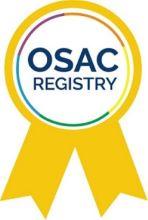
The FSSB recently approved the addition of the following 11 standards to the OSAC Registry.
Biology/DNA
- ANSI/ASB Standard 020, Standard for Validation Studies of DNA Mixtures, and Development and Verification of a Laboratory's Mixture Interpretation Protocol, First Edition, 2018. Added to the Registry on May 5 and initially developed by OSAC’s Biological Data Interpretation and Reporting Subcommittee, this document describes the requirements for the design and evaluation of internal validation studies for mixed DNA samples and the development of appropriate interpretation protocols for mixtures based on the validation studies performed. This standard applies to any type of DNA testing technology and methodology used where mixtures of DNA may be encountered, analyzed and interpreted.
- ANSI/ASB Standard 040, Standard for Forensic DNA Interpretation and Comparison Protocols, First Edition, 2019. Added to the Registry on May 5 and initially developed by OSAC’s Biological Data Interpretation and Reporting Subcommittee, this document describes requirements for a laboratory’s DNA interpretation and comparison protocol and provides direction for its development.
Bloodstain Pattern Analysis
- ASB Technical Report 033, Terms and Definitions in Bloodstain Pattern Analysis, First Edition, 2017. Initially drafted by OSAC’s Bloodstain Pattern Analysis Subcommittee, this is the first bloodstain pattern analysis document to be included on the Registry. Added on June 3, this Registry approved standard contains a list of recommended terms and definitions that address basic bloodstain pattern types and related concepts.
Digital Evidence
The following three standards were initially drafted by OSAC's Digital Evidence Subcommittee and are the first digital evidence documents to be added to the Registry, effective July 7.
- ASTM E2916-19e1 Standard Terminology for Digital and Multimedia Evidence Examination. This document is a compilation of terms and corresponding definitions used in the examination of digital and multimedia evidence to include the areas of computer forensics, image analysis, video analysis, forensic audio, and facial identification.
- ASTM E3017-19 Standard Practice for Examining Magnetic Card Readers. This practice provides information on seizing, acquiring, and analyzing skimming devices capable of acquiring and storing personally identifiable information (PII) in an unauthorized manner.
- ASTM E3150-18 Standard Guide for Forensic Audio Laboratory Setup and Maintenance. This guide provides recommendations for the creation of a forensic audio laboratory space as well as the configuration, verification, and maintenance of the equipment contained within the lab.
Materials (Trace)
- ASTM E1967-19 Standard Test Method for the Automated Determination of Refractive Index of Glass Samples Using the Oil Immersion Method and a Phase Contrast Microscope. Added to the Registry on July 7 and initially developed by OSAC’s Materials (Trace) Subcommittee, this test method covers a procedure for measuring and comparing the refractive index at a fixed wavelength and temperature of glass from known sources to recovered fragments from a questioned source.
- ASTM E2330-19 Standard Test Method for Determination of Concentrations of Elements in Glass Samples Using Inductively Coupled Plasma Mass Spectrometry (ICP-MS) for Forensic Comparisons. Added to the Registry on July 7 and initially developed by OSAC’s Materials (Trace) Subcommittee, this test method describes a procedure for the quantitative determination of the concentrations of magnesium (Mg), aluminum (Al), iron (Fe), titanium (Ti), manganese (Mn), rubidium (Rb), strontium (Sr), zirconium (Zr), barium (Ba), lanthanum (La), cerium (Ce), neodymium (Nd), samarium (Sm), and lead (Pb) in glass samples.
Toxicology
- ANSI/ASB Standard 036, Standard Practices for Method Validation in Forensic Toxicology, First Edition, 2019. Added to the Registry on July 7 and initially drafted by OSAC’s Toxicology Subcommittee, this document defines minimum standards of practice for validating analytical methods used in the field of forensic toxicology that target specific analytes or analyte classes. Specifically, it is intended for the subdisciplines of postmortem forensic toxicology, human performance toxicology (e.g., drug-facilitated crimes and driving-under-the-influence of alcohol or drugs), non-regulated employment drug testing, court-ordered toxicology (e.g., probation and parole, drug courts, child services), and general forensic toxicology (non-lethal poisonings or intoxications).
Wildlife Forensics
The following two standards were initially drafted by OSAC’s Wildlife Forensics Subcommittee and are the first wildlife forensics documents to be added to the Registry, effective June 3.
- ANSI/ASB Standard 028, Wildlife Forensics Morphology Standards, First Edition, 2019. This document provides minimum standards for wildlife forensic analysts in the subdiscipline of morphology.
- ANSI/ASB Standard 047, Wildlife Forensics Validation Standard—Validating New Primers for Sequencing, First Edition, 2019. This document provides minimum requirements and recommendations for validating new primers for mitochondrial haplotyping and/or taxonomic identification via sequencing in wildlife forensic DNA laboratories where the sequencing (Sanger) method has already been validated.
To access these and the other 25 standards currently on the OSAC Registry, visit the OSAC Registry webpage.
OSAC Registry Implementation: How to Guide Now Available
OSAC’s mission is to facilitate the development of science-based standards and to encourage the use of these standards throughout the forensic science community. By adhering to the standards on the OSAC Registry, a laboratory can increase confidence in the accuracy, reliability, and reproducibility of its results.
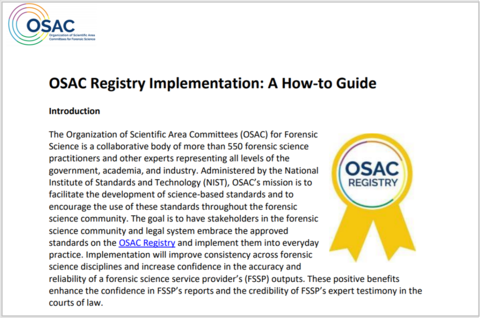
To help laboratories and other forensic science service providers (FSSPs) implement these standards, OSAC has developed the OSAC Registry Implementation: A How-to Guide. This guide describes the various pathways laboratories can take to incorporate OSAC Registry standards into their management processes and documents and provides examples of successful implementation.
The OSAC Registry Implementation: A How-to Guide is available on the OSAC Registry Implementation webpage.
If your organization has implemented standards from the OSAC Registry and would like to be a resource for others, let us know. Email forensics [at] nist.gov (forensics[at]nist[dot]gov) to share your “how-to” experience and help others on the journey.
OSAC in Action
OSAC's Digital/Multimedia Scientific Area Committee Develops New Guidance on Non-routine Offsite Forensic Examination of Digital/Multimedia Evidence

The unprecedented impact of COVID-19 has led to social distancing, travel restrictions, and closure of non-essential facilities. Many organizations have teleworking strategies to address these constraints. Forensic laboratories and practitioners are not exempt from these circumstances, yet they must maintain continuity of forensic examinations. Unfortunately, there is no “one size fits all” approach, as organizations vary in their ability to support remote operations. What’s more, there are many questions about how to maintain the integrity of the process in the current situation. After speaking with colleagues and participating in online forums, OSAC’s Digital/Multimedia Scientific Area Committee published Guidance on Non-routine Offsite Forensic Examination of Digital/Multimedia Evidence.
Unlike many forensic disciplines, digital/multimedia evidence examination can often be done remotely. The ability to forensically duplicate digital/multimedia evidence, in accordance with best practices, makes remote examinations possible. This established practice can be leveraged when coupled with a contingency plan that supports a secure remote examination environment that maintains evidence integrity.
Organizations must consider the risks when conducting remote examinations. These can include confidentiality, integrity and fidelity risks. These risks can likely be mitigated by actions already implemented in an existing management system.
The Guidance on Non-routine Offsite Forensic Examination of Digital/Multimedia Evidence is available on OSAC’s Digital/Multimedia Scientific Area Committee webpage.
New OSAC Technical Series Publication Available: Human Factors in Validation and Performance Testing of Forensic Science
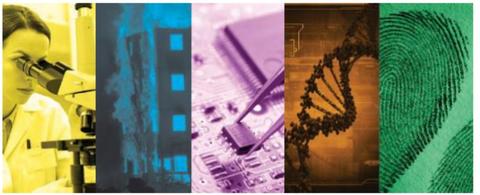
Research on the validity of methods and examiner performance plays an important role in advancing forensic science. OSAC has published a document that provides guidance on designing, conducting, and reporting this research. This new Technical Series Publication, Human Factors in Validation and Performance Testing of Forensic Science, brings together key points from the scientific literature on assessing human performance.
This publication is not a standard or guideline and offers no requirements for current or future practice. Rather, it is an OSAC Technical Series Publication designed to provide background and perspective on issues relevant to the standards development process. It was initially drafted by OSAC’s Human Factors Committee (now Human Factors Task Group) after several OSAC subcommittees asked for guidance on designing research to evaluate human performance in forensic science.
This document focuses on the human element—the accuracy and consistency of examiners who must rely on expert judgment to complete their analyses. It discusses the strengths and weaknesses of several research approaches and provides suggestions on incorporating more and better research into standard laboratory practice.
According to William Thompson, Chair of the Human Factors Task Group, this publication is “one of the most thoroughly vetted documents to emerge from OSAC.” The review process took over two years and involved over 300 comments and extensive revisions that were “necessary to assure that the document addresses the diverse needs of the forensic science community and takes account of different perspectives.”
The document discusses issues of critical importance to forensic scientists who design, conduct and evaluate research either to confirm the validity of forensic science methods or evaluate and improve laboratory procedures. According to Thompson, the document “is a must-read for laboratory directors and quality managers and will be an essential guidebook for anyone conducting or evaluating research on human performance in a forensic laboratory.”
Human Factors in Validation and Performance Testing of Forensic Science is available on the Human Factors Task Group webpage.
Calling all CSIs: Participate in a Survey and Help OSAC's Crime Scene Investigation Subcommittee Make Recommendations for Future Staffing Levels

Crime scenes are complex and the investigators who process them may be required to work long hours in poor conditions. The resulting stress and fatigue can lead to errors and to the burnout of personnel.
To help address a need for research about adequate staffing levels at crime scenes, an independent investigator, in collaboration with OSAC’s Crime Scene Investigation (CSI) Subcommittee, has developed a survey to evaluate the factors that affect the quality and effectiveness of an investigation, determine what investigators can effectively handle alone, and assess when and how much extra staff is needed.
All CSI practitioners are encouraged to provide their input to this survey by August 31, 2020.
The collected data will be submitted to a peer-reviewed journal and will inform OSAC’s Crime Scene Investigation Subcommittee as it works to make discipline-wide recommendations for proper staffing at crime scenes.
Materials (Trace) Interlaboratory Data Collection Exercise to Evaluate Draft Standard

OSAC’s Materials (Trace) Subcommittee is conducting an interlaboratory data collection exercise to evaluate its draft document, Standard Practice for Interpretation and Report Writing in Forensic Comparison of Trace Materials, before submitting it to ASTM for formal development.
Over 100 participants have volunteered to join in the first round of the study, which focuses on forensic paint analysis. A web-based training session was held on June 11 to introduce the exercise to participants, who will work through 15 scenarios this summer. After the exercise ends on Aug. 14, the subcommittee will use the responses to revise and finalize the draft standard. They will also share the summary of data and results.
The draft document can be found on the Materials (Trace) Subcommittee webpage.
If you have questions or would like to participate in the exercise, please register here.
OSAC Program Office News
Calling All Forensic Science Experts

Make an impact on the forensic science community by participating in the standards development process. Numerous membership terms will expire this September and OSAC is currently looking to fill expected vacancies on its committees and subcommittees.
Read more about the new application process below and consider applying to join OSAC!
Important Changes to the OSAC Application Process

The new OSAC application form is now available. This form has been revised for ease of use and to limit the amount of personal identification information submitted online. Applicants can indicate their areas of expertise and preference for serving on subcommittees, Scientific and Technical Review Panels (read more on this below), and Interdisciplinary Committees.
All existing members and affiliates will need to submit new applications using the new application form. Having all members and affiliates submit new applications will ensure all applicant information is current and will conform to OSAC’s future data sorting scheme.
Applications will be kept on file for three years only. After this application “reset” and to keep future data current, applications will be kept on file for only three years. After three years, members and affiliates must re-apply. The application pool will be purged on a rolling basis each year on October 1.
Scientific and Technical Review Panels: A New Way to Become Involved in OSAC
Do you want to participate in the standards development process but can’t commit the time to be an OSAC member? As part of OSAC 2.0, OSAC will be launching Scientific and Technical Review Panels (STRPs). In addition to forensic science practitioners, STRPs will include experts in scientific research, statistics, human factors, and the law. The role of the STRP will be to discuss and assess a standard’s scientific and technical merit and provide feedback to the drafting subcommittee. STRP members will share their assessment in an interim report to the subcommittee and in a final report for the public.
Consider sharing your expertise! If you’d like to participate on an STRP, complete the OSAC application form and be sure to check the box indicating you wish to volunteer on an STRP.
OSAC Standards Activities at a Glance
Here’s a snapshot of the status of forensic science standards on the OSAC Registry and in the development process for each of OSAC’s 25 subcommittees and interdisciplinary task groups:
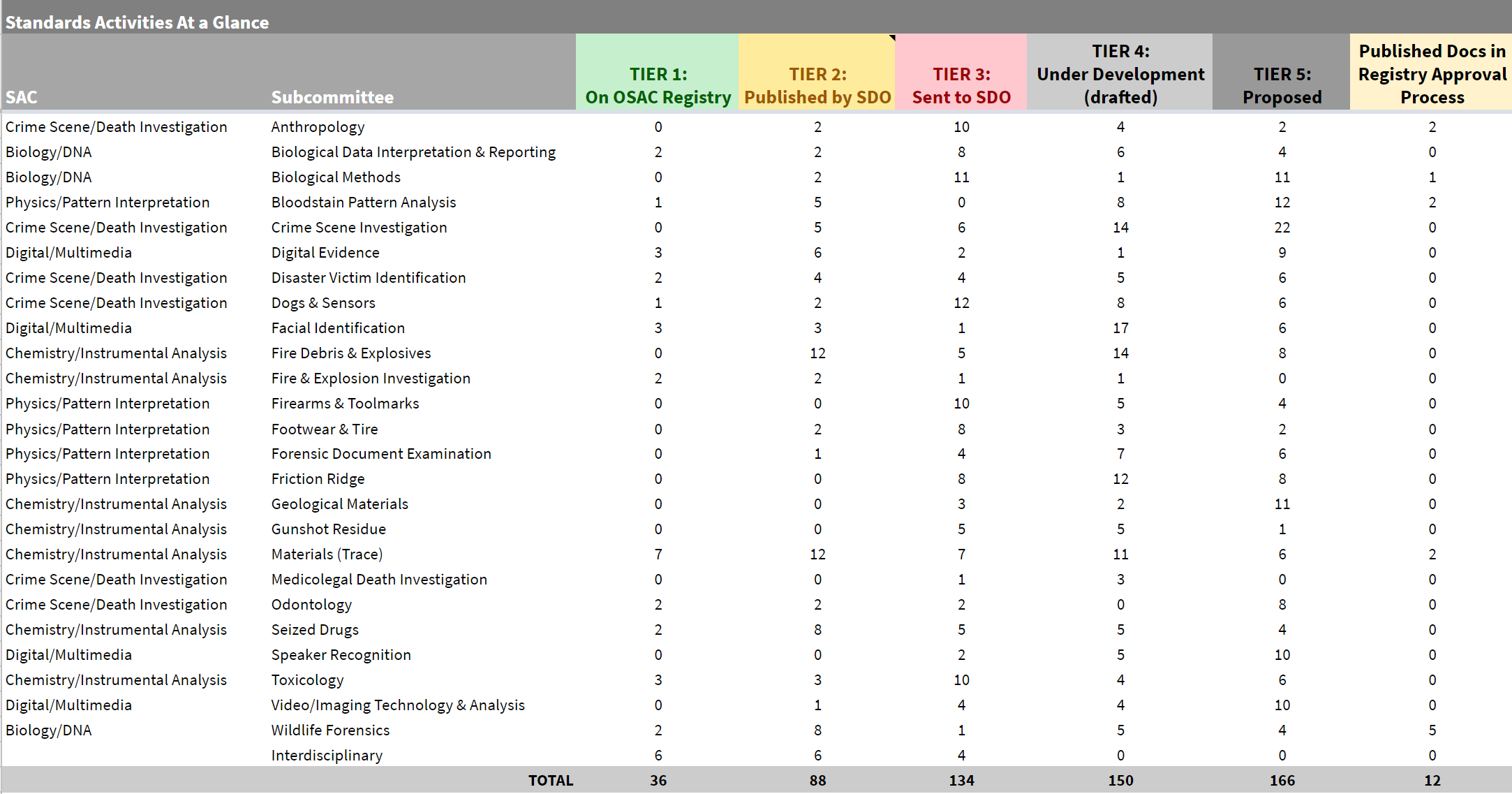
Key:
- Tier 1: A document on the OSAC Registry; approved by OSAC with the highest vetting.
- Tier 2: OSAC supported document that completed the SDO consensus process and was published by an SDO.
- Tier 3: An OSAC draft document that was sent to an SDO for further development. The document was drafted with input from OSAC's resource task groups and approved by the SAC.
- Tier 4: A working draft document inside OSAC's development process and not yet publicly available.
- Tier 5: A proposed idea or concept for a standard, but not yet drafted.
For a complete list of the standards in development process, visit the relevant OSAC subcommittee webpage.
Professional Organization Spotlight
The International Association for Identification
by OSAC FSSB IAI representative Steve Johnson
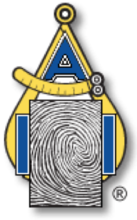
The International Association for Identification (IAI) is the oldest and one of the largest associations of forensic professionals in the world. With over 7000 members, the IAI represents international public, private and government practitioners of forensic science and law enforcement. Members range from those beginning or considering a career in forensics to seasoned experts. Many are considered leaders in their field. Many IAI members are certified in one or more of the eight disciplines overseen by the Forensic Certification Management Board (FCMB) and have received their certification from the IAI following a series of rigorous written and practical examinations. Those eight disciplines are Latent Print Examination, Tenprint Examination, Bloodstain Pattern Analysis, Forensic Photography, Forensic Video, Crime Scene, Footwear and Forensic Art. Over 2,300 forensic specialists are certified through the IAI and FCMB.
The purpose of the IAI is to bring together practitioners of forensic identification, investigation, and scientific examination of physical evidence into an organized body and to promote standardization and effective scientific practice. Other goals include:
- Encouraging the enlargement and improvement of the forensic sciences.
- Encouraging research in the forensic sciences.
- Keeping members appraised of the latest techniques and discoveries in the forensic sciences.
- Employing the collective wisdom of the profession to advance the forensic sciences.
- Providing training, education and the publication of information in forensic science disciplines represented by the Association.
- Providing educational opportunities throughout the year at international and regional conferences.
There are approximately 75 IAI members working to develop standards within OSAC. Additionally, dozens of IAI members are activity involved in the standards development process through participation on consensus bodies and other standards development organization committees. In early 2014, the IAI was one of six forensic science associations invited to the NIST Gaithersburg campus to discuss the formation and implementation of OSAC. Pursuant to the IAI’s goals, development and adoption of standards across the spectrum of forensic disciplines is essential to the services provided to our many practitioner members. Many IAI members are serving OSAC in a leadership capacity as they apply to the specific disciplines represented by our Association. IAI continues to provide our members the latest information and accomplishments from OSAC through our annual conference and by sharing OSAC’s Newsletter, In Brief and, when appropriate, blast emails in order to maintain transparency and clarity regarding the OSAC mission.
Upcoming Events
September 2020
1 OSAC Leadership Strategy Session (virtual)
16-17 FSSB quarterly meeting (virtual)
December 2020
7-9 Virtual meetings for Chemistry: Seized Drugs & Toxicology SAC and subcommittees, Chemistry: Trace Evidence SAC and subcommittees, and Biology SAC and subcommittees
May 2021
TBD Meetings for Scene Examination SAC and subcommittees and Physics/Pattern Interpretation SAC and subcommittees in Orlando, Florida
June 2021
TBD Meetings for Digital/Multimedia SAC and subcommittees and Medicine SAC and subcommittees in Orlando, Florida
TBD Meetings for Biology SAC and subcommittees, Chemistry: Seized Drugs & Toxicology SAC and subcommittees, and Chemistry: Trace Evidence SAC and subcommittees in Orlando, Florida
OSAC in the News

Development of the Term “Exclusionary Difference” and a More Uniform Use of Spectral Comparison Language
Read more from Diana Wright, chair of OSAC’s Materials (Trace) Subcommittee, in the July 2020 issue of the American Society of Trace Evidence Examiners (ASTEE) Newsletter, page 11, regarding a brief history of the evolution of the terms used to describe the differences between items being compared from “significant” to “meaningful” to “exclusionary differences".
Solving Daubert’s Dilemma for the Forensic Sciences Through Blind Proficiency Testing
This Houston Law Review article describes the Houston Forensic Science Center’s blind proficiency testing program and mentions several OSAC recommendations on the topic.
Just a Statistical Approach to Glass Evidence
Hear from Jose Almirall, chair of OSAC’s Chemistry/Instrumental Analysis SAC, about a statistical approach for the interpretation of glass evidence in this Forensic Technology Center of Excellence podcast.
Two New Forensic DNA Standards Added to the OSAC Registry
Read about the two OSAC Registry approved standards covering the interpretation of DNA evidence. This article was also printed in the Forensic Newsletter and Evidence Technology Magazine.
The ISHI Report – May 2020
Click on the Update from the Organization of Scientific Area Committees (OSAC) section in this ISHI Report to hear from Robyn Ragsdale, chair of OSAC’s Biology/DNA SAC, and learn about the latest DNA standards added to the Registry.
NIST Activities
NIST Adds New ‘Fingerprints’ to Chemical Identification Database
NIST has updated its database of mass spectra, which contains chemical fingerprints, that are used to identify unknown chemical compounds.
NIST to Digital Forensics Experts: Show Us What You Got
Digital forensics experts often extract data from computers and mobile phones that may contain evidence of a crime. Now, researchers at NIST will conduct the first large-scale study to measure how well those experts do their job. But rather than testing the proficiency of individual experts, the study aims to measure the performance of the digital forensics community overall.
NIST Study Measures Performance Accuracy of Contactless Fingerprint Tech
NIST has evaluated several commercially available contactless fingerprint scanning technologies, allowing users to compare their performance to conventional devices that require physical contact between a person’s fingers and the scanner.
In Glowing Colors: Seeing the Spread of Drug Particles in a Forensic Lab
Black-light videos from NIST will help crime labs manage an invisible risk.

